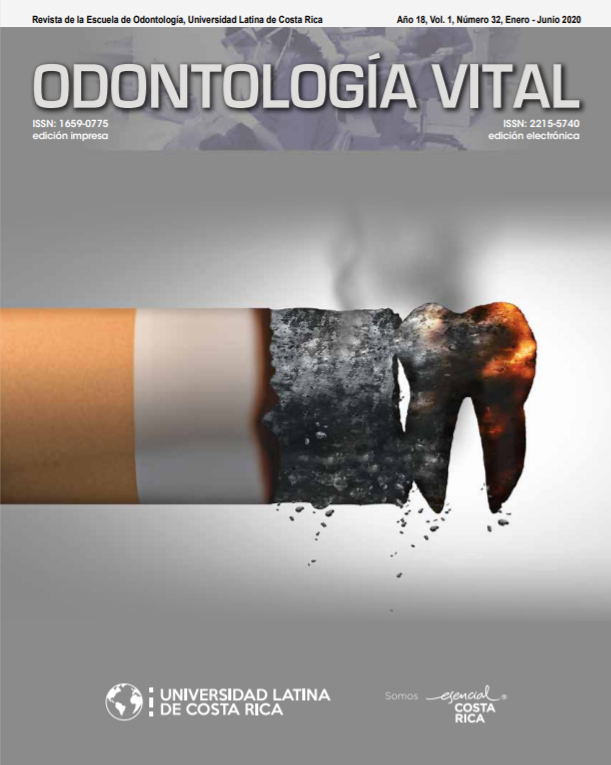Non-surgical Therapeutics of large size periapical injury: Clinical case report
DOI:
https://doi.org/10.59334/ROV.v1i32.377Keywords:
Dental trauma, periapical injury, bioceramics, biodentine, apexification, periapical diseases, endodontic obturationAbstract
This report describes a clinical case involving a 21 year-old woman, who suffered dental trauma at age 6, compromising left tooth 2.1. On time she developed a large periapical injury in this area. Radiographically, incomplete root formation, thin walls of the root canal, and extensive periapical damage is clearly shown. Chemomechanical debridement was performed with K files and disinfection of the root canal using 2% chlorhexidine. The root canal was left medicated with calcium hydroxide (Metapex), which was replaced periodically until 9 months. Finally, the root canal was completely sealed with Biodentine. The case had a follow up for over four years and concerning esthetical aspects, through this period of time an internal whitening, resin veneer, intra radicular post and complete crown were provided. Regarding the considerable periapical injury, tomography shows that it has been drastically reduced and generated bone healing. Clinical observations also show that the fistula and symptomatology disappeared.
Downloads
References
Bakland L.K., Andreasen J.O. (2012). Will mineral trioxide aggregate replace calcium hydroxide in treating pulpal and periodontal healing complications subsequent to dental trauma? a review. Dent Traumatol ; 28:25–32. https://doi.org/10.1111/j.1600-9657.2011.01049.x
Castellucci, A. (2002). Endodontics. Edizioni Odontoiatriche il Tridente. 2nd ed. 370 ppohen, Stephen, Burns, Richard C. PATHWAYS OF THE PULP. 8th. ed. Mosby. St Louis.
Lasala, A. (1992). Patología pulpar y periapical en: Endodoncia. Ediciones Científicas y Técnicas. 4ta Edición. Capítulo 4.
Manzur A., Gonzáles, A.M., Pozos, A., Silva-Herzog D., Friedman S. (2007). Bacterial quantification in teeth with apical periodontitis related to instrumentation and different intracanal medications: a randomized clinical trial. J Endod ; 33:114–8. https://doi.org/10.1016/j.joen.2006.11.003
Moule, A.J., Moule, C.A. (2007). The endodontic management of traumatized permanent anterior teeth: A review. Aust Dent J ;52(1 Suppl): S122-37. https://doi.org/10.1111/j.1834-7819.2007.tb00520.x
Park ,J., y Lee, J., (2008). Use of mineral trioxide aggregate in the open apex of a maxillary first premolar, Journal of Oral Science, vol. 50, no. 3, pp. 355–358. https://doi.org/10.2334/josnusd.50.355
Patil, S., Patil, A., y Dodwad, P., (2011). Management of nonvital teeth with open apices using MTA as an apical plug: two case reports, World Journal of Dentistry, vol. 2, pp. 45–48. https://doi.org/10.5005/jp-journals-10015-1052
Shekhar, V. y Shashikala, K., (2013). Cone beam computed tomography evaluation of the periapical status of non-vital tooth with open apex obturated with mineral trioxide aggregate: A Case Report, Case Reports in Dentistry, vol. 2013, Article ID 714585, 6 pages. https://doi.org/10.1155/2013/714585
Tanomaru, F. M, Leonardo, M.R., Silva, L.A.B., et ál. (2002). Inflammatory response to different endodontic irrigating solutions. Int Endod J ; 35:735–9. https://doi.org/10.1046/j.1365-2591.2002.00544.x
Torabinejad, M., Parirokh, M. (2010). Mineral trioxide aggregate: a comprehensive literature review—part II: leakage and biocompatibility investigations. J Endod ;36: 190–202. https://doi.org/10.1016/j.joen.2009.09.010
Tziafa, C., Koliniotou-Koumpia, E., Papadimitriou, S., Tziafas, D. (2014). Dentinogenic responses after direct pulp capping of miniature swine teeth with Biodentine. J Endod ;40: 1967–71. https://doi.org/10.1016/j.joen.2014.07.021
Vidal, K., Martin, G., Lozano, O., Salas, M., Trigueros, J., Aguilar, G., (2016). Apical closure in apexification: A review and case report of apexification treatment of an immature permanent tooth with biodentine, J Endod. https://doi.org/10.1016/j.joen.2016.02.007
Zanini, M., Sautier, J.M., Berdal, A., et ál. (2012). Biodentine induces immortalized murine pulp cell differentiation into odontoblast-like cells and stimulates biomineralization. J Endod ; 38:1220–6. https://doi.org/10.1016/j.joen.2012.04.018
Zmener, O., Pameijer ,C.H., Banegas, G. (2007). An in vitro study of the pH of three calcium hydroxide dressing materials. Dent Traumatol ;23:21–5. https://doi.org/10.1111/j.1600-9657.2005.00447.x
Downloads
Published
Issue
Section
License
Copyright (c) 2020 María José Rodriguez; Mayid Barzuna

This work is licensed under a Creative Commons Attribution 4.0 International License.
Authors who publish with Odontología Vital agree to the following terms:
- Authors retain the copyright and grant Universidad Latina de Costa Rica the right of first publication, with the work simultaneously licensed under a Creative Commons Attribution 4.0 International license (CC BY 4.0) that allows others to share the work with an acknowledgement of the work's authorship and initial publication in this journal.
- Authors are able to enter into separate, additional contractual arrangements for the non-exclusive distribution of the Odontología Vital's published version of the work (e.g., post it to an institutional repository or publish it in a book), with an acknowledgement of its initial publication.
- Authors are permitted and encouraged to post their work online (e.g., in institutional repositories or on their website) prior to and during the submission process, as it can lead to productive exchanges, as well as earlier and greater citation of published work.







